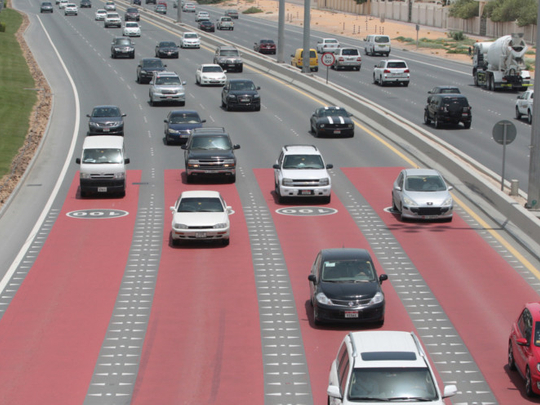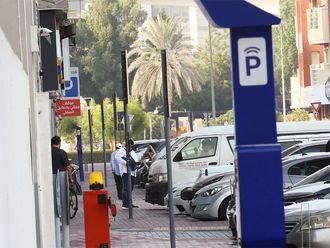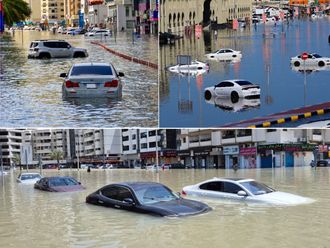
Abu Dhabi: Notwithstanding a population of 1.7 million, Abu Dhabi last year had one of the lowest levels of traffic congestion among cities of a similar size, an international traffic index report revealed.
Peak hour travel in Abu Dhabi takes only 14 minutes longer than during non-peak hours, a panel of international traffic experts at the TomTom Awards said at a press conference in the capital on Monday.
There has been a 6 per cent increase in travel time during peak hours this year compared to last year, but traffic experts said this is a natural result of population growth.
In addition, Abu Dhabi was rated the best among 390 cities at using infrastructure to manage its traffic flow in 2016, traffic experts said.
“Abu Dhabi has proven that a highly-planned road system that maximises labour mobility and goods movement can bring efficiency and reduce congestion. In fact, the city has one of the best TomTom Traffic Index congestion levels of any city with a population of more than a million,” the panel said.
The TomTom traffic index ranked 390 cities based on congestion, using data collected from smartphone apps, GPS applications, and from taxi and bus monitoring systems. Only the city of Katowice in Poland had similarly low levels of congestion in the group of metropolises with populations between one and eight million.
“We have invested over Dh581 million towards improving traffic management systems in the last few years, and winning this international award is indicative of this great progress,” said Awaidah Al Marar, chairman of the Department of Municipal Affairs and Transport (DMAT), which regulates the municipal and transportation sectors in the emirate.
Much of this investment has been used to install intelligent traffic control systems in the capital. For instance, traffic signals are now monitored smartly through a computerised system that ensures as continuous a flow of traffic as possible.
“The system has been in place for more than a year and a half, and motorists have found that they can keep driving, without having to stop, past six subsequent intersections on average. This is because of the intelligent manner in which the signals are synchronised, compared to the manual system used in the past, and it has reduced delays by about 20 per cent,” Salah Al Marzouqi, director for integrated intelligent transportation systems at the DMAT, told Gulf News on the sidelines of the conference.
Another enhancement has been the roll-out of the Darb smartphone application, which allows residents to book taxis, check on real-time bus schedules and stay abreast of traffic incidents and developments. In addition, fare collection systems within the city’s 520 buses were also automated.
“We have earmarked another Dh900 million for further development. A portion of this has been used to set up variable message signboards to manage traffic on the highways, and another portion will be used to enhance the bus network and fleet. We also plan to look into deploying autonomous, ‘driverless’ vehicles,” Al Marzouqi said.
“Traffic congestion requires continuous efforts, and an integrated management system that combines infrastructure building, technology use and monitoring. Abu Dhabi looks into all these different elements. I would, however, recommend a greater focus on providing more varied public transportation options,” said Ralf-Peter Schafer, vice-president for traffic and travel information at TomTom.
According to officials at the Integrated Transport Centre at the DMAT, Abu Dhabi has reduced annual traffic congestion by 14 per cent in recent years.
“The implementation of advanced traffic management systems, such as the Variable Time Schedule, has resulted in reduced peak waiting times in Abu Dhabi city centre by six per centre, outside it by 31 per cent, and in islands like Al Reem and Al Maryah by 50 per cent. During off-peak times, this waiting period has been reduced by 75 per cent in the city centre, and by up to 97 per cent in other areas,” said Mohammad Al Qamzi, general manager at the Centre.
“In addition, the replacemente of roundabouts with signalised intersections in Mohammad Bin Zayed City has reduced trip times by 10 per cent during the morning peak hours, and 25 per cent at non-peak times,” he added.
Highlights of report
Abu Dhabi has lowest level of traffic congestion among cities with 1-8 million population
Best city in using infrastructure to manage traffic
Most congested areas in Abu Dhabi: Zayed the First Street (Electra Street), sections of Sultan Bin Zayed the First Street (Muroor Road), and roads near Musaffah
- 9,285km road network in Abu Dhabi
- 14 minutes increase in peak hour travel time in Abu Dhabi compared to non-peak hours
- November 30, 2016 is the day with most traffic congestion last year
TomTom Traffic Index for 2016
Most congested city: Mexico City, Mexico
Least congested city: Dayton, US
Least congested city outside US: Abu Dhabi, Katowice, Poland, Brasilia and Curitiba in Brazil, Konya, Turkey
Note: For cities with a population of more than 800,000 people












